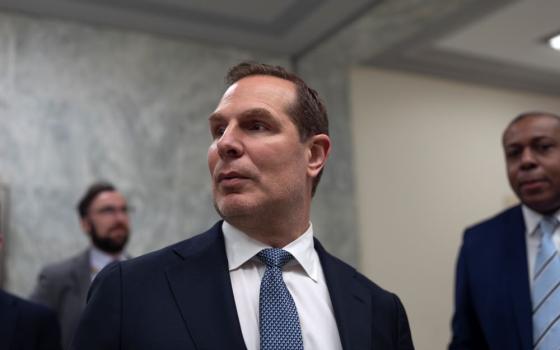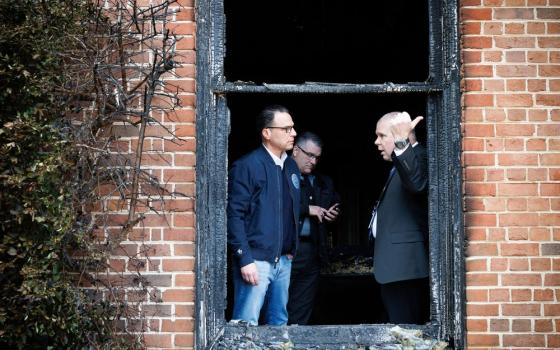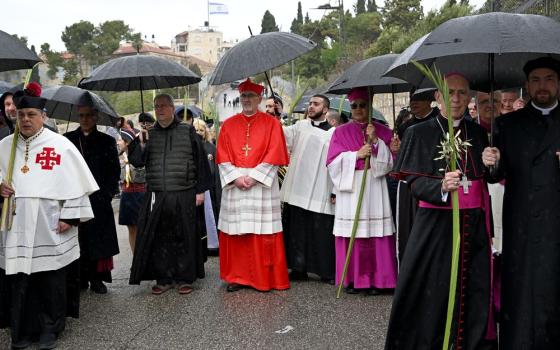
The sky at the Cerro Tololo in the Valle de Elqui, Chile, Oct. 11, 2015. (CNS photo/AURA Observatory of Chile via EPA)
One of the greatest liturgical challenges of the church in the 21st century is to figure out how to do liturgy in a way that is meaningful to people in a post-Darwin, post-Einstein, post-Hubble world.
Traditional liturgical prayer, based on biblical imagery, presumes a pre-scientific worldview where Earth is the center of the universe and the world was created quickly and perfectly. Everything was wonderful until Adam sinned.
In fact, the universe is some 13.8 billion years old, with organic life appearing about 3 billion years ago, and humans evolving relatively recently. Rather than appearing in an idyllic paradise, humans crawled out of the mud fighting, scratching out an existence in a brutal and highly competitive environment.
Current liturgical worship requires that we park our scientific minds at the church door and enter into the pre-scientific world of our ancestors when we pray. This schizophrenic existence is not viable in the long run. How do we do liturgy with people having a "quantum-cosmological, developmental-evolutionary worldview," asks Jesuit Fr. Robert Daly, who has been thinking about this question for a number of years.
This is no easy task. In truth, it is part of a larger task of theologians trying to figure out how to make Christianity intelligible to people in the 21st century.
Daly finds inspiration for his work in theologians like Elizabeth Johnson (Ask the Beasts: Darwin and the God of Love), Dawn Nothwehr (Ecological Footprints: An Essential Franciscan Guide for Faith and Sustainable Living), and Dennis Edwards (Partaking of God: Trinity, Evolution, and Ecology).
Here we see theologians grappling with ancient questions of Christology, ecclesiology and soteriology in the context of contemporary science.
These theologians are imitating the great theologians of the past — Augustine and Thomas Aquinas — who used the intellectual thought of their times to explain Christianity to their contemporaries. Augustine used Neoplatonism and Aquinas used Aristotelianism because these represented the intellectual worldviews of their times. Today’s theologians who use science and contemporary thought are very traditional; they are simply following in the footsteps of Augustine and Aquinas.
But in some ways, Daly's challenge is even greater because what he wants to do will impact not only the thinking of the intellectually curious, but also the lived experience of worship of millions of Christians. If you think the translation wars were rough, you ain't seen nothing yet.
Daly recognizes this challenge and says his "goal has been to formulate prayer/praying in which both people comfortable in a pre-modern, pre-critical, pre-scientific worldview and people comfortable in a quantum-cosmological, developmental, evolutionary worldview can happily pray together."
He first presented his thinking in a March 2015 article in Worship, "Ecological Euchology." Euchology is a book of the Orthodox church containing Eucharistic rites and other liturgical matters.
Included in this article was a first draft of a Eucharistic prayer designed for contemporary worship. This draft did not include a "preface."
Last week, Father Daly presented a revised draft with preface to the Seminar on Eucharistic Prayer and Theology of the North American Academy of Liturgy (NAAL) meeting in Washington, D.C. Although the prayer has been discussed at the seminar for the last three years, he acknowledges that the prayer is still a draft.
"Its language, imagery and rhythms need to be honed by the praying and proclaimed experience of many mouths and communities," he wrote. "It betrays the awkwardness of an early attempt to pray in a language that is not only traditionally biblical in its allusiveness, but that is also ecologically sensitive."
It is "at least referentially expressive of the thoughts and feelings of a modern scientist," but at the same time not so obtrusive "as to alienate those not fully at home in that world of thought."
In short, he attempted to write "a poetic, Trinitarian song of praise and thanksgiving expressing the feelings and aspirations of a Judaeo-Christian faith that is also comfortable with a quantum-cosmological, developmental-evolutionary worldview."
Daly's Eucharistic prayer includes all of the traditional classical elements of a model Eucharistic prayer in the Basil/Chrysostom tradition: Introductory dialogue, preface, Sanctus, anamnesis, institutional narrative, acclamation, epiclesis, solemn petitions and doxology.
After the introductory dialogue ("The Lord be with you. …"), he begins with words of praise in the preface:
Father, we praise you, with all your creatures
great and small,
from measureless galaxy
to tiniest particle.
They all came forth from your hand.
Filled with your presence,
they are signs of your undying love:
Praise be to you!
A. Praise be to you!
From the very first sentence, the Eucharistic prayer goes beyond an Earth-centric and visible world to include "measureless galaxy" and "tiniest particle." These are seen as "signs of your undying love," and the congregation responds with "Praise be to you!" The congregation gives praise not by itself but "with all your creatures."
With a Trinitarian focus, the prayer goes on to Jesus and the Spirit:
Word of God, Jesus, we praise you.
Through you all these things were made
and have their being.
And when you took your bodily shape
in the womb of Mary our mother,
you entered into the chaos of our lives
to bring us to the beauty of your love:
Praise be to you!
A. Praise be to you!
Holy Spirit, we praise you,
who breathed over the primal chaos,
spoke to us through the prophets' voices,
hovered over Mary's womb
and made us temples of your love:
Praise be to you!
A. Praise be to you!
The scientifically literate would note references to "chaos theory" in this section of the Eucharistic prayer, but not in a way that marginalizes the scientifically illiterate.
After the Sanctus, the Eucharistic prayer continues with more images from contemporary understanding of creation:
Where once was nothing, your love
brought matter into being and motion,
thus creating time itself,
and countless galaxies, each with its countless stars,
and, to prepare a home for us,
delicately circling round a single star,
this one small globe, our mother earth.
And on this globe, aeons later,
you brought forth, infinitely small, but inexorably growing,
the beginnings of the life we share with all that lives.
And then, past billions of years,
past aeons of seemingly random developments,
past the seeming chaos of countless extinctions
— but springing from those deaths ever new forms of life —
your Word breathed not just life but Spirit too
into man and woman, your image and likeness.
Thus, the creation of man is put into the context of the creation of not only galaxies and stars but matter and time itself. Nor does man appear in some idyllic Eden.
Past further countless generations you lovingly watched us grow,
becoming part of the life-death-life
of all that lives and grows on earth,
until, at last, you made a rainbow covenant with us
bringing us to know you more clearly as our Maker
and ourselves as your people.
Only then does the Eucharistic prayer connect us to Abraham, the prophets, and ultimately to Jesus, "born of the Spirit and of Mary's YES, to enter into the chaos of our earthly lives. …"
After the institutional narrative, the acclamation is addressed to the Father, rather than to Jesus, which allows the congregation to not only remember the death and resurrection of Jesus but also to offer to the Father the sacrifice of this Eucharist:
Remembering his cross and death,
and mindful of his loving words,
we give you praise and thanks, O Lord,
and offer you this bread and cup,
while offering ourselves,
until he comes again.
The prayer continues with calling down the Spirit in the epiclesis:
Mindful, then, of your loving gift,
and in awesome praise of the chaos-beauty
of the constant death-into-life
of this your garden globe,
and mindful too of your mandate to bless and keep it
with the same loving care with which
You bless and keep us, we pray:
Send down on us and on these gifts
full portions of your Holy Spirit
who with your Word and before all time
brought forth the galaxies,
breathed over the primal waters,
came upon the prophets
and hovered over Mary's womb.
The calling down of the Spirit in this epiclesis is the same Spirit that was present at creation and that has been active throughout time. In prayer, the congregation asks that this same Spirit may help us to "know our place in this your universe, on this your earth, and in this your Church." All of this "so that in and through our living, dying, and rising with your Son we may learn to till and keep this earth with the same love with which you till and keep us."
This Eucharistic prayer is a first attempt to imitate the early fathers of the church who wrote similar prayers to fit their historical and cultural contexts. Daley understands that the role of liturgists is not simply to learn from the past but also to speak to the present in prayer and song in a way that responds to our changed worldview.
The prayer, as Daly acknowledges, is not perfect. (Click here to read the full prayer.) For example, I find it impossible to proclaim the sentence beginning "Where once was nothing. …" One of the seminar participants suggested it be split into shorter sentences.
Another questioned directing the prayer in the preface and doxology to the Trinity rather than only to the Father, as is traditional in Eucharistic prayers from the fifth century on. Most Eucharistic prayers are addressed to the Father, through the Son, in the Spirit. Some found breaking with that tradition disconcerting.
The most interesting comments came from members of the NAAL's Ecology and Liturgy Seminar, who joined the discussion.
One suggested having the prayer reflect the idea that the incarnation began with the Big Bang and using the language of energy when speaking of the Spirit.
Another suggested that when using the word "we," the prayer might include not only humans but all creation. Likewise, the Spirit would be described as inhabiting all nature, not just humans. One even suggested that when speaking of the Father sending the patriarchs and prophets to teach us, the prayer also recall the sending of locusts, floods and other natural phenomena.
Another participant suggested that the payer be more explicitly environmental rather than solely scientific. In other words, reflect the thinking of environmentalists like John Muir rather than just scientists like Darwin.
Despite the suggestions, all participants agreed this is an admirable attempt to create a Eucharistic prayer for the 21st century, a prayer that can resonate with the scientifically literate and environmentally sensitive. Members of the seminar also acknowledged that no one prayer can include everything without becoming too long and too complicated. Rather than trying to get everything in one prayer, it would be better to have a number of prayers.
Immediately after Vatican II, many celebrants were writing their own Eucharistic prayers with little knowledge of what they were doing. In suppressing these excesses, the Vatican also shut down more intelligent experimentations. Liturgists concluded that it was a waste of time working on new Eucharistic prayers that would never get approved. Creativity continued in Protestant churches, but not in Catholicism.
With the papacy of Pope Francis, perhaps the church is ready for a period of limited experimentation by liturgical professionals working with congregations willing to be beta sites for new liturgical practices. This would allow for creativity, testing, and adjustments before any new practice is let loose on the entire church.
Meanwhile, liturgical professionals are doing the slow work of thinking about and discussing the how to do liturgy in the 21st century.
[Jesuit Fr. Thomas Reese is a senior analyst for NCR and author of Inside the Vatican: The Politics and Organization of the Catholic Church. His email address is treesesj@ncronline.org.]
Editor's note: We can send you an email alert every time Thomas Reese's column, Faith and Justice, is posted. Go to this page and follow directions: Email alert sign-up.




